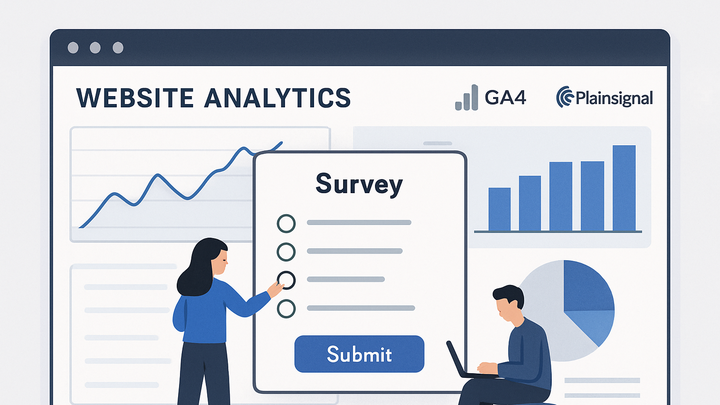Published on 2025-06-26T04:30:34Z
What are Surveys in Analytics? Examples and Usage
Surveys in analytics are structured questionnaires embedded within a digital property or delivered via email to collect qualitative feedback and user insights. They complement quantitative metrics by capturing opinions, preferences, and satisfaction levels that raw data alone cannot convey.
By integrating survey responses with analytics platforms like GA4 or PlainSignal, organizations can correlate user behavior with sentiment, identify pain points, and validate hypotheses. Surveys can take various forms—including pop-ups, embedded forms, and in-app prompts—and may be customized to trigger based on user context or behavior.
When implemented effectively, surveys become a powerful tool for understanding user motivations, improving the customer experience, and driving data-informed product decisions.
Surveys
Structured questionnaires to collect user feedback and integrate responses with analytics tools for qualitative insights.
Overview of Surveys in Analytics
This section introduces the concept of surveys within digital analytics, explaining what they are, their key benefits, and the types commonly used to collect qualitative feedback.
-
Definition
Surveys are sets of structured questions—multiple choice, rating scales, or open-ended—that gather user opinions, preferences, and feedback.
-
Key benefits
Surveys provide context to numeric analytics by revealing the ‘why’ behind user behavior, helping teams prioritize improvements and measure satisfaction.
-
Common survey types
Surveys can be delivered in various formats depending on the platform and user context.
-
Pop-up surveys
Modal or slide-in widgets triggered by user actions like time on page or exit intent.
-
Embedded surveys
Inline forms placed within content areas to capture feedback during specific interactions.
-
Email surveys
Delayed feedback requests sent via email after key events such as purchase or onboarding.
-
In-app surveys
Interactive prompts displayed inside web or mobile applications at strategic moments.
-
Implementing Surveys with Analytics Tools
Learn how to deploy and track surveys using popular analytics platforms like PlainSignal (cookie-free) and Google Analytics 4 (GA4).
-
Cookie-free tracking with PlainSignal
Add the following snippet to your page head to enable PlainSignal’s cookie-free analytics and survey event tracking:
<link rel="preconnect" href="//eu.plainsignal.com/" crossorigin /> <script defer data-do="yourwebsitedomain.com" data-id="0GQV1xmtzQQ" data-api="//eu.plainsignal.com" src="//cdn.plainsignal.com/plainsignal-min.js"></script>Once installed, PlainSignal automatically captures pageviews and custom events like survey submissions without cookies.
-
Privacy compliance
Operates without cookies or personal identifiers, simplifying GDPR and CCPA adherence.
-
Event capture
Tracks custom events (e.g., survey_start, survey_submit) out of the box.
-
-
Integrating surveys in GA4
To track survey interactions in GA4, send custom events via gtag.js or Google Tag Manager upon survey start and completion. For example:
gtag('event', 'survey_submit', { 'survey_type': 'NPS', 'response_score': 9 });-
Custom event setup
Define events like
survey_startandsurvey_submitin your GA4 property to capture survey metrics. -
Parameter tracking
Use parameters (e.g.,
survey_id,question_count,response_score) to enrich analysis.
-
-
Embedding third-party survey tools
Platforms like SurveyMonkey, Typeform, or Qualtrics can be embedded and tracked by listening for their form submission events and forwarding them to your analytics stack.
-
Event listeners
Implement JavaScript listeners to detect survey completions and fire analytics events.
-
Data sync
Use available APIs or webhooks to automatically import survey responses into your data warehouse or analytics platform.
-
Best Practices for Effective Survey Analytics
Guidelines to design, deploy, and analyze surveys that deliver actionable insights when combined with analytics data.
-
Question design
Craft clear, concise questions that avoid jargon or bias. Use a mix of multiple-choice and open-ended formats to balance structure and depth.
-
Targeting and timing
Trigger surveys based on user behavior (e.g., page scroll depth, time on site) and limit frequency to reduce fatigue.
-
Segmentation
Display surveys to specific user cohorts or traffic sources for more relevant feedback.
-
Frequency control
Set session or cookie-based limits to avoid over-surveying the same user.
-
-
Analyzing survey data
Combine survey responses with behavioral metrics to uncover correlations, validate hypotheses, and prioritize improvements.
-
Cross-analysis
Compare survey answers against segments (e.g., new vs. returning users) in your analytics reports.
-
Qualitative coding
Use tagging or NLP to categorize open-ended feedback for trend analysis.
-
